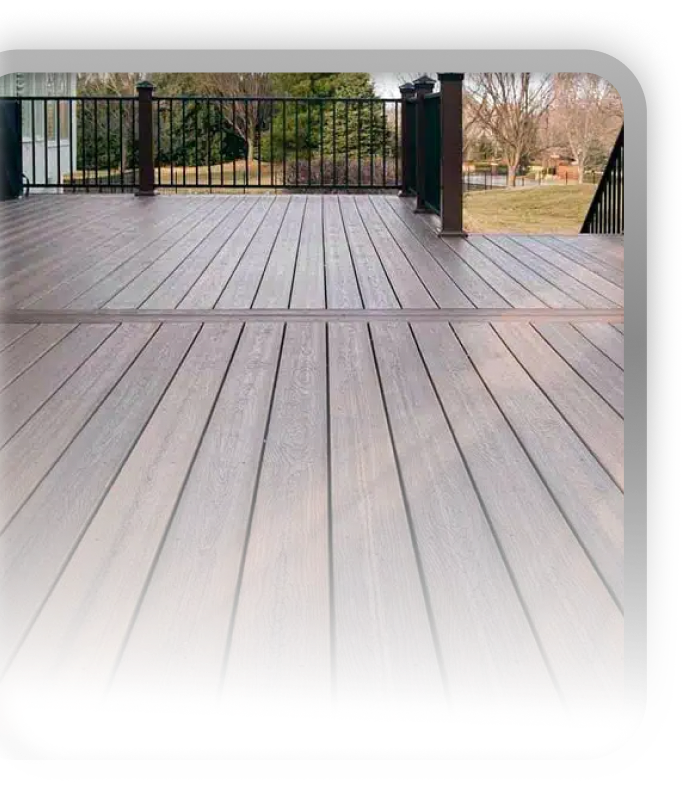Siding Repair & Installation in Pierce & King County, WA
Free Estimates | Owner Operated | Financing Available

Deck Builders in Pierce & King County, WA
Free Estimates | Owner Operated | Financing Available


Fast and Affordable
Home Decking
Upgrade outdoor living with professional deck building, repairs, and replacements. We serve Pierce & King County with composite and wood options, built to current code with proper framing, flashing, and rail details. We size joists, spans, and guards to prescriptive guides and manufacturer specs for a deck that performs and lasts.
We offer complete services, including:
Composite Decking (low-maintenance boards with manufacturer-specified gaps/fasteners)
Railings (36″ residential guard height; 4″ sphere baluster spacing)
Stairways (coded handrails/guards, solid stringer connections)
Demolition & Deck Painting (removals, surface prep, and protective coatings)
Beam Support & Staircase Installation (framing, blocking, and secure connections)
Ledger/Flashing Upgrades (water-managed house connections)
Whether you already have plans or you’re starting fresh, our team will confirm scope, materials, and timeline—then deliver a clean, on-schedule installation.
Call (253) 300-9969 for a FREE estimate. Financing available.
Complete Decking Services
Cedar

Vinyl

Hardie Plank

hardwood

Cedar

composite

Composite Decking
Modern looks with low maintenance. We follow the brand’s span/joist specs (typically 16″ OC straight, 12″ on diagonal) to control deflection and keep boards tight.
Cedar & Pressure-Treated Wood
Warm, natural decking with proper fasteners and clearances. We use corrosion-resistant (hot-dip galvanized or stainless) fasteners/connectors compatible with treated lumber.
Hardwood (Ipe, etc.)
Dense, premium hardwoods installed with attention to ventilation, gapping, and fastening systems for long service life.
Railings & Guards
Clean designs that meet residential guard rules (36″ min height and ≤4″ openings; stair exceptions apply).
Stairs & Landings
Safe treads/risers, secure stringers, and code-compliant handrails for everyday use.
Framing, Footings & Ledger
Posts, beams, joists, and flashed ledgers built to prescriptive standards for a solid structure and dry connection to the house.
If you’re interested in our decking services, make sure to get
in touch with our team today. You can reach us by using the
Request an Estimate tab or by calling us at
We look forward to working with you!
Deck Builders FAQ
Do I need a permit for a new or replacement deck?
Often, yes—especially if the deck is over 30″ above grade, attached to the house, or >200 sq ft. Local rules vary: King County exempts uncovered decks ≤30″; Pierce County says 30″ needs a permit; Seattle requires permits over 18″ high. Always check your city/county before work begins.
How tall does the railing have to be (and how tight the pickets)?
For decks that need guards, the IRC minimum is typically a 36″ guard height with openings under 4″ (local amendments may vary).
Can I put composite decking over my existing wood deck boards?
Best practice is to remove old boards, inspect/repair the frame, then install composite on the joists. Manufacturers show resurfacing on a sound substructure—not laying new composite over old deck boards.
What joist spacing do composite boards need?
Most brands call for 16″ on center when boards run perpendicular to joists and 12″ OC when installed diagonally (heavier loads/patterns may also require 12″). Always follow the specific product’s manual.
What fasteners/connectors should I use with pressure-treated framing?
Use hot-dip galvanized (ASTM A153/G185) or 304/316 stainless fasteners and compatible connectors; avoid plain steel/aluminum in treated wood due to corrosion risk. Follow the fastener/connecter manufacturer’s guidance.
How do you flash the ledger where the deck meets the house?
Code requires corrosion-resistant flashing at the ledger, integrated “shingle-fashion” with the wall’s WRB to keep water off the band joist; siding is removed in the ledger zone and continuous flashing with drip edge is typical.
What’s the simplest way to keep a composite deck clean?
Regularly sweep/blow debris, then wash with warm, soapy water and a soft-bristle brush; this removes the biofilm that feeds mold on the surface. Rinse well and avoid harsh cleaners unless the brand allows it.
Our Awards





Our Partners







